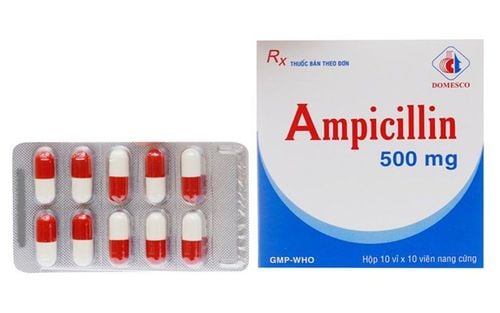1. What is Cefoperazone Sulbactam?
Cefoperazone Sulbactam is a medication containing two main components: Cefoperazone (in the form of Cefoperazone sodium) 0.5g and Sulbactam (in the form of Sulbactam sodium) 0.5g.
It belongs to the third-generation cephalosporin series of semi-synthetic antibiotics and contains the Cefoperazone component. By preventing the formation of bacterial cell walls during growth and division, it is well known for its ability to effectively kill bacteria. The majority of gram-negative bacteria create beta-lactamases, which cefoperazone is extremely resistant against. Therefore, this component exhibits strong activity against a broad range of gram-negative bacteria, including strains like N. gonorrhoeae producing penicillinase and genera such as Enterobacter, Citrobacter, Proteus, Morganella, Providencia, Salmonella, Shigella, and Serratia spp. Notably, it is particularly effective against bacteria resistant to other beta-lactam antibiotics.
The Sulbactam component is structurally similar to beta-lactam but has weak antibacterial activity and is thus rarely used alone in clinical settings. Sulbactam can inactivate beta-lactamase enzymes, thereby protecting beta-lactam antibiotics from degradation. Consequently, Sulbactam is commonly used in combination with penicillin to expand penicillin’s activity spectrum against bacteria like intestinal bacteria, E. coli, staphylococci, anaerobes such as Bacteroides, Acinetobacter, Branhamella, Klebsiella, Neisseria, Proteus, and others.
2. Indications and Contraindications of Cefoperazone Sulbactam
2.1 Indications
Cefoperazone Sulbactam is formulated as an injectable drug and is indicated for treating infections caused by specific susceptible bacteria:
- Patients with upper and lower respiratory tract infections.
- Patients with upper and lower urinary tract infections.
- Individuals with conditions such as peritonitis, cholecystitis, cholangitis, and other abdominal infections.
- Patients with blood infections, skin and soft tissue infections, bone and joint infections, pelvic infections, and meningitis.
- Individuals with infections of the endometrial lining, gonorrhea, and other genital organ infections.
2.2 Contraindications
Cefoperazone Sulbactam is contraindicated in individuals with a history of allergies to penicillin, sulbactam, cefoperazone, or other cephalosporin antibiotics.
3. Dosage and Administration of Cefoperazone Sulbactam
Cefoperazone Sulbactam is prepared for intramuscular injection or intravenous infusion, with reference doses as follows:
- Adults: For mild to moderate bacterial infections, administer 1-2g (Cefoperazone) every 12 hours. For severe bacterial infections, administer 2-4g every 12 hours.
- Children: Administer 25-100 mg/kg every 12 hours.
Note: Patients with kidney disease do not require dosage adjustment. However, for those with liver disease or bile duct obstruction, ensure the dosage does not exceed 4g/24 hours.
4. Side Effects of Cefoperazone Sulbactam
According to healthcare experts, Cefoperazone Sulbactam is well-tolerated, with most side effects being mild to moderate. Common side effects include:
- Nausea, vomiting, or diarrhea.
- Skin allergies present as rash or hives.
- Long-term use may lead to reversible leukopenia, positive Coombs test reactions, decreased red blood cells, transient eosinophilia, and reduced platelets. In some cases, hypoprothrombinemia has been noted.
5. Drug Interactions of Cefoperazone Sulbactam
Cefoperazone Sulbactam may interact with certain medications:
- Concurrent use with aminoglycoside antibiotics reduces the drug’s activity. If required, administer separately and flush the infusion line between doses.
- Use cautiously with anticoagulants, thrombolytic agents, and certain nonsteroidal anti-inflammatory drugs, as these increase bleeding risk.
- Avoid combining with drugs containing components like amikacin, gentamicin, kanamycin B, doxycycline, meclofenoxate, ajmaline, diphenhydramine, or potassium magnesium aspartate.
6. Precautions When Using Cefoperazone Sulbactam
- Use caution when administering Cefoperazone Sulbactam to patients allergic to penicillin.
- Cefoperazone Sulbactam can be combined with other antibiotics to treat certain severe infections. However, when combined with aminoglycoside antibiotics, kidney function should be monitored throughout treatment.
- Use Cefoperazone Sulbactam in pregnant or breastfeeding women only when absolutely necessary.
- Administer the correct dosage to avoid overuse, which may cause increased neuromuscular excitability and seizures, especially in patients with kidney failure. In such cases, hemodialysis can remove Cefoperazone and Sulbactam from the body.
The above information provides insights into Cefoperazone Sulbactam. To prevent antibiotic resistance, use the medication strictly as prescribed by doctors and healthcare professionals. Avoid self-medication or abrupt discontinuation, as these actions may pose risks to health.
Follow the Vinmec International General Hospital website for additional health, nutrition, and beauty information to safeguard the health of yourself and your loved ones.
To arrange an appointment, please call HOTLINE or make your reservation directly HERE. You may also download the MyVinmec app to schedule appointments faster and manage your reservations more conveniently.













